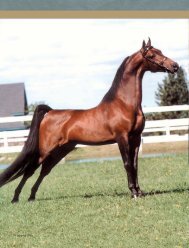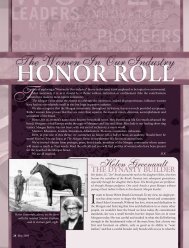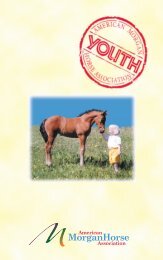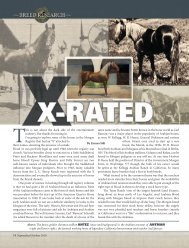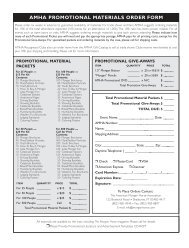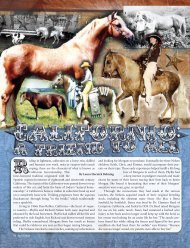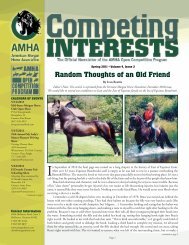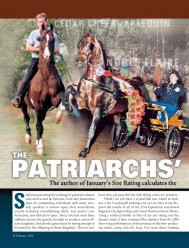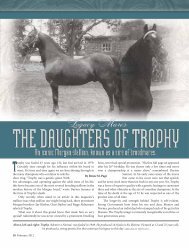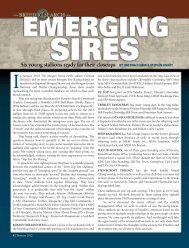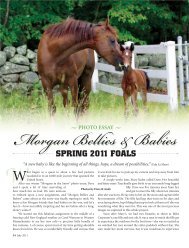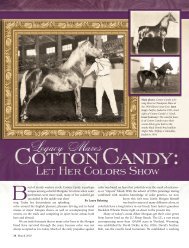see more about the TMH issue. - Blackthorne Morgans
see more about the TMH issue. - Blackthorne Morgans
see more about the TMH issue. - Blackthorne Morgans
Create successful ePaper yourself
Turn your PDF publications into a flip-book with our unique Google optimized e-Paper software.
David and Amelia Ladd. One of those days a fa<strong>the</strong>r never forgets...Michelle Hoyt (foreground) and Amelia ridemid-pack as <strong>the</strong> group picks its way backthrough <strong>the</strong> herd of resident horses.Ionce dreamed of being a cowboy. That isn’t big news; mostevery boy dreamed of being a cowboy in <strong>the</strong> 1950s and1960s when I was young. Unlike many, though, I guess Inever outgrew it. Growing up in New England and raisingmy family and my <strong>Morgans</strong> here, <strong>the</strong> West has long <strong>see</strong>med like anelusive adventure I might never know. That was, until I celebrated<strong>the</strong> Morgan by living that dream, if only for a little while.While I readily admit to being new to <strong>the</strong> Morgan world with<strong>about</strong> a dozen years under my belt, I have been strongly drawn to<strong>the</strong> breed by its history, its character, and by those who share anadmiration for this wonderful horse. Inevitably, with myunquenched desire to be a cowboy and a strong interest in history,I found my way to a group of Morgan enthusiasts with a particularlabel of “Working Western <strong>Morgans</strong>.” I joined <strong>the</strong>ir e-maillist server and made new friends with people I’d never met. This isa jovial group who are not shy <strong>about</strong> poking fun at each o<strong>the</strong>r or,preferably, me.Amid <strong>the</strong> humor and wonderful photographs of <strong>Morgans</strong>, oftenperforming real ranch work, <strong>the</strong>re was a recurring discussion <strong>about</strong>an event called <strong>the</strong> “Fort Rob Ride.” I soon learned that many of <strong>the</strong>group ga<strong>the</strong>red each year for a fun ride to Celebrate <strong>the</strong> Morgan andthat this annual event had been held for <strong>the</strong> past three years at aplace called Fort Robinson, Nebraska. To my delight, <strong>the</strong>y weregoing to return <strong>the</strong>re last September, and I was invited.I planned my trip for months and counted down <strong>the</strong> days. Ivisited <strong>the</strong> Fort Robinson website so often that <strong>the</strong>y had to installa separate “hit counter” just for me! Finally, on September 19, my20-year-old daughter Amelia and I embarked on our westernadventure to celebrate <strong>the</strong> Morgan horse on a historic cavalry fortin <strong>the</strong> Wild West.After driving through Wyoming from <strong>the</strong> DenverInternational Airport, we arrived at Fort Robinson a little afternoon on Thursday, ahead of <strong>the</strong> o<strong>the</strong>r riders and <strong>the</strong> horses.Though I had brought my own saddle, we would be riding borrowed<strong>Morgans</strong> and were anxious to get started. As <strong>the</strong> afternoonpassed, several trucks with trailers arrived carrying friends I hadnever met and <strong>the</strong>ir Working Western <strong>Morgans</strong>.While helping unload <strong>the</strong> horses from <strong>the</strong>ir trailers, I foundmyself in awe, as <strong>the</strong>se were clearly <strong>Morgans</strong>, but not ones I wasused to. These <strong>Morgans</strong> were bred to work and were a wondroussight to behold. I couldn’t help but notice <strong>the</strong> great bone and hugemuscle mass of <strong>the</strong>se horses. I could stand and look at <strong>the</strong>m all daylong and never tire of <strong>the</strong>ir incredible presence. Tomorrow,though, we would ride <strong>the</strong>m and it couldn’t be soon enough.Fort Robinson is now a Nebraska state park and is rich in <strong>the</strong>history of <strong>the</strong> West. Within <strong>the</strong>se 22,000 acres, 11,000 cavalryhorses and 8,000 army mules once grazed. The Cheyenne uprisingand death of <strong>the</strong> famous Sioux warrior chief Crazy Horse
Left to right; Amelia Ladd, Donna Barrett,Michelle Hoyt, Karen Thiel, and Linnea Sidi.Fort Robinson today. Only a fraction of <strong>the</strong> buildings remain, but <strong>the</strong> State ofNebraska maintains <strong>the</strong>m beautifully and is a gracious host.Supporting cast. These longhorn cattleprovide an undeniable photo opportunity.Family reunion. As <strong>the</strong> group settles in for <strong>the</strong> evening in <strong>the</strong> officer’s housing,relationships of participants’ Morgan horses are charted and pictures passedwhile <strong>the</strong> Sears boys provide <strong>the</strong> evening entertainment.occurred here. From this fort, <strong>the</strong> U.S. Cavalry soldiers, manymounted on <strong>Morgans</strong>, made <strong>the</strong>ir mark in history for better or forworse. From <strong>the</strong> historic horses at this cavalry remount station,including <strong>the</strong> famous Morgan stallion Linsley, descended some of<strong>the</strong> horses we would be riding tomorrow.The State of Nebraska has beautifully restored and maintainedmany of <strong>the</strong> original military structures, including barns,barracks, and officers quarters that now serve as guesthouses.Because we were <strong>the</strong>re in <strong>the</strong> off-season, some of <strong>the</strong> amenitieswere closed, but we had all that we needed though, including agreat cook in Merideth Sears of AFS <strong>Morgans</strong>, and a cowboy rightout of “central casting” in her husband, Tony.Friday morning finally arrived and it was time to ride. I awoketo <strong>the</strong> smell of breakfast before <strong>the</strong> sun was up and gradually all of<strong>the</strong> riders appeared for a superb meal. Even Amelia was awakebefore <strong>the</strong> crack of noon, a sure sign of her enthusiasm for thisremarkable event.Before long, we were mounted and headed to <strong>the</strong> plains. Mymount for <strong>the</strong> morning was named Arapaho Kate (SidehillThunder x Sidehill Electra), who was big and bold and had beenspecially selected as <strong>the</strong> HBFGBE (Horse for <strong>the</strong> Big Fat Guy fromBack East). Amelia was riding on Trailhead Scarlet Rose (TrailheadCyrus x Trailhead Primrose), a choice bay mare bred and ownedby Bob and Donna Barrett.Riding through <strong>the</strong> fort and a few gates, we soon foundourselves in an open plain and headed for a spectacular butte.As we rode toward it, I was totally absorbed in <strong>the</strong> open space, <strong>the</strong>scenery, and <strong>the</strong> joy of riding with this bunch. Suddenly, I becameaware of some slight alarm at <strong>the</strong> head of <strong>the</strong> column. As I focusedmy attention, I was overcome by <strong>the</strong> magnificent sight of a herd of<strong>about</strong> 30 horses galloping toward us over a slight rise that had,until now, been hidden from our view.The spectacle of those horses charging toward us against thisbackdrop of classic western scenery completely enveloped me in<strong>the</strong> moment. My attention soon was diverted, however, as Iassessed <strong>the</strong> fact that I was sitting on a horse with 30 days of training,who I had ridden a total of ten minutes, and who also was“off-<strong>the</strong>-reservation” (so to speak) for <strong>the</strong> very first time.Moreover, we were being charged by a herd of 30 horses!To my delight, Kate took it in stride and stood quietly whilewe determined <strong>the</strong> intention of <strong>the</strong> now integrated herd. As I sat,I had yet ano<strong>the</strong>r opportunity to reflect on <strong>the</strong> born nature of<strong>the</strong>se <strong>Morgans</strong>. None of <strong>the</strong> 15 or so horses in our group stirred as<strong>the</strong> o<strong>the</strong>r horses ran upon <strong>the</strong>m. One could attribute this to <strong>the</strong>iruse as ranch horses, but not all were; clearly <strong>the</strong> steadfast naturewas part of <strong>the</strong>ir breeding.With Linnea Sidi leading us, we picked our way through<strong>the</strong> herd of horses and made our way toward <strong>the</strong> looming
Top, middle: Stan Todorovich of 777 <strong>Morgans</strong>, ahorseman’s horseman astride Krila’s Avalanche.Right, top: Marty Thiel of Blackheart <strong>Morgans</strong>from North Dakota models full cavalry tack andattire ...some of us never outgrow it. Right, bottom:Post Headquarters historical marker.rock. The sheer faces of <strong>the</strong>se buttes are set in <strong>more</strong> gentle, butoften steep, hills of sand, washed from <strong>the</strong> faces of rock throughoutcenturies. Few options exist when mounting <strong>the</strong>se giants, as<strong>the</strong> paths often cut through narrow passages. Thus steep climbsand descents are <strong>the</strong> menu of <strong>the</strong> ride.Around every corner and over each rise, <strong>the</strong> scenery changed.We would traverse ridges bringing us to peak after peak, manywith abrupt ends that provided scenic overlooks in every direction.Our band would make its way into, <strong>the</strong>n through, a group ofevergreens, only to emerge with a new vista and a nearly differentenvironment. Clearly this was all foreign to us New Englanders;our senses were filled with this new experience. On our way backdown, as I was thinking it, Amelia turned to me from her horseand said, “I feel like I’m on a movie set.” We had just experiencedour first ride in <strong>the</strong> Wild West. This would be our sole ride onFriday, as <strong>the</strong> afternoon would be our only opportunity to visit <strong>the</strong>fort museum and <strong>the</strong> natural history museum. The latter featured<strong>the</strong> fossilized remains, discovered nearby, of two giant mammothsthat became locked in battle and died toge<strong>the</strong>r.Later that evening, <strong>the</strong> much-awaited Shery Jespersen arrivedwith her horses. Shery is, to <strong>the</strong> Working Western Morgan Internetlist, a blend of Zane Grey and Joe Rosenthal. Her thoughtful writtendescriptions of daily ranch life accompanied by artistic photographyallow many of us to live ranch life vicariously. These talentsare topped off by Shery’s ability to create fine jewelry. Manyin <strong>the</strong> group, including me, were anxious to meet <strong>the</strong> womanbehind <strong>the</strong>se talents and her mare, Roseta Sage LR, who is featuredin many of her pictures.In addition to bringing two of her <strong>Morgans</strong>, Shery brought anassortment of jewelry that she had made at <strong>the</strong> request of those ofus who had <strong>see</strong>n pictures. Thinking I should bring back somethingfor my wife who couldn’t get time off to come to <strong>the</strong> ride, Isent Amelia to scout out <strong>the</strong> jewelry. I ended up buying a smallsomething for my wife and a whole bunch of bling for Amelia.We finished <strong>the</strong> evening in good company in <strong>the</strong> living roomof our shared officers quarters. All of <strong>the</strong> riders assembled, alongwith a herd of dogs, and were serenaded by Andy and Skeeter Sears.As might be expected, conversation centered on our commonbond, <strong>the</strong> Morgan horse. Shared pictures and lineage diagramsmade <strong>the</strong> event <strong>see</strong>m <strong>more</strong> of a family reunion than a meetingof new friends as we found our horses’ common ancestors.One memorable discussion centered on <strong>the</strong> point that somany in <strong>the</strong> country and in <strong>the</strong> Morgan community aren’t awarethat cattle are still worked on horseback and in particular on<strong>Morgans</strong>. The ranchers in <strong>the</strong> room take <strong>the</strong>ir work and attendantlifestyle as a matter of simple reality. It’s what <strong>the</strong>y do, it’s hardwork, and <strong>the</strong>ir <strong>Morgans</strong> are <strong>the</strong>ir partners in <strong>the</strong>ir daily routine.As we discussed <strong>the</strong>ir lives, I noted that few outside of it cantruly appreciate that this lifestyle still exists. Using my own experiences,I explained that many riders and Morgan owners I knowseldom ride outside of an enclosure and if <strong>the</strong>y do trail ride, <strong>the</strong>ytend to be only a few acres.Saturday brought us ano<strong>the</strong>r unseasonably warm day. Italready was in <strong>the</strong> upper 80s when we finished breakfast and wouldreach 95 by midday. You know what <strong>the</strong>y say <strong>about</strong> dry heat? It’strue! At 95 degrees back home I would be hiding in air conditioning,but with no humidity, it was downright comfortable.Saturday’s ride would start east of <strong>the</strong> fort buildings and barns,so we trailered our horses to a starting point called Soldier Creek androde from <strong>the</strong>re. I changed horses this day as well. My mount for <strong>the</strong>day would be a young bay mare owned by Shery Jespersen namedBahia Belle LR (ML Meadowlark Jazzspur x Apple Pi Blue Belle).Soldier Creek <strong>see</strong>med to be <strong>the</strong> only waterway still flowing in<strong>the</strong> area. Though hardly a raging river, <strong>the</strong> creek provided somespectacular oasis environments as we rode through <strong>the</strong> highdesert. We descended from steep hills of dry vegetation and cactusinto lush wild gardens of green vegetation and even flowers.Horses would stop and play or take a drink as we crossed, providingan opportunity for <strong>the</strong> rider to enjoy <strong>the</strong> view.Taking a position at <strong>the</strong> rear of <strong>the</strong> group, I had <strong>the</strong> opportunityto appreciate <strong>the</strong> size of <strong>the</strong> now expanded group of ridersand <strong>the</strong> spectacle of <strong>the</strong> long line of <strong>Morgans</strong> moving up anddown <strong>the</strong> steep terrain. I could clearly <strong>see</strong> that my daughter andher roommate of <strong>the</strong> trip, Michelle Hoyt, had become friends andperiodically rode toge<strong>the</strong>r. Michelle, who could talk a dog off of abone, was very proud of her Morgan gelding, Payton Breeze, whoreveled at every challenge.While not an accomplished trail rider in <strong>the</strong> terms of many, Ihave ridden trails with many horses before. The loose, steepascents and descents of <strong>the</strong>se trails would challenge any horse and
Oasis. The many crossings of Soldier Creek offered lush greens and softcolors in contrast to <strong>the</strong> dry, high ground. Michelle Hoyt on Payton Breezein <strong>the</strong> foreground, Karen Thiel on Black Heart’s Magic in <strong>the</strong> creek.rider. The ups and downs, however, paled in comparison to trailsrunning along <strong>the</strong> sides of hills that drop easily 70 degrees or <strong>more</strong>from a path no wider than 16 inches. A spooked horse on <strong>the</strong>ridgeline trails could be catastrophic for horse and rider, yet noMorgan faltered and none hesitated.One brave Morgan, who was as foreign to this land as I, hadspent her life doing things o<strong>the</strong>r than riding <strong>the</strong> trails and plains,yet she never flinched. JJF Lady J Takes Command was not aWorking Western Morgan, but a Third Level Dressage and carriagehorse. Her owner, Shirley Christian, proudly proclaimed thatbefore this ride her mare “hadn’t <strong>see</strong>n <strong>more</strong> water than her automaticwaterer would hold.” Yet true to her breed, she took everyhill, downed tree, and stream like a champ.Along <strong>the</strong> morning trail, we were faced with crossing adowned tree trunk that was probably three feet above ground.While <strong>the</strong> horses had no problem in stepping over <strong>the</strong> trunk, eachhad to “rise” to <strong>the</strong> occasion. As I crossed this obstacle, my cowboyhat became caught in a branch and was taken from my head. I wassuddenly confronted with a true crisis; leave <strong>the</strong> hat or dismounton this steep and narrow trail to recover it.Assessing my trusty Morgan, I was determined to save my hat.Dismounting on <strong>the</strong> foot-wide path, I turned my trusty steed andwalked back to <strong>the</strong> offending tree. There lay my hat in <strong>the</strong> midst ofits branches. The rescue was successful and I was able to remountwithout so much as a pause from this Morgan. Of course, I was <strong>the</strong>lucky one. Shery Jespersen had failed to wear a hat, so <strong>the</strong> samebranch that ate my hat managed to catch her braided hair. Ouch!Dang thing nearly pulled her right out of <strong>the</strong> saddle!As we descended from this series of hills, we had a slightlylarger water hazard, offering those of a <strong>more</strong> sporting mindset <strong>the</strong>opportunity to dive ra<strong>the</strong>r than wade <strong>the</strong>ir horses through. Ofcourse, Amelia and I could not resist. After all, we were <strong>the</strong>re for<strong>the</strong> whole experience, weren’t we?Sadly, this ride concluded after <strong>about</strong> three hours. I knew thatthis would be <strong>the</strong> last long ride of <strong>the</strong> trip. I again had <strong>see</strong>n countrythat had, for me, only existed in movies. I again gained anappreciation of <strong>the</strong>se Morgan horses and <strong>the</strong>ir intelligence andwilling demeanor. Moreover, I had <strong>the</strong> chance to share this experiencewith my daughter, an opportunity nei<strong>the</strong>r lost nor underappreciatedby my fellow riders.There would be one <strong>more</strong>, brief, evening ride for us as <strong>the</strong>sun set that evening. That ride was led by Stan Todorovich,grandson of a Texas Ranger, who <strong>see</strong>med to have been born in <strong>the</strong>saddle. Stan spent most of his life working for Morganbreeder/rancher/outfitter, Ramul Dvarshkis, of Wyoming. Therugged hand took us one last time to <strong>the</strong> buttes where he talked of<strong>the</strong> routine of <strong>the</strong> soldiers of Fort Robinson who climbed <strong>the</strong> peakof <strong>the</strong>se giant rocks each Sunday for church services. From thisvantage point, we would watch hues of <strong>the</strong> landscape transformedone last time from khaki and green to <strong>the</strong> reds and blues reflectedby <strong>the</strong> sky on <strong>the</strong> plains and rock faces of <strong>the</strong> buttes as <strong>the</strong> sun set.We bid farewell to those friends we could find on Sundaymorning, as some had ventured out for ano<strong>the</strong>r ride. During <strong>the</strong>ride to Denver, Amelia and I had an opportunity to recall <strong>the</strong>events and share our impressions. We had truly celebrated <strong>the</strong>Morgan horse! We gained a new appreciation of an entirely differentdimension of this wonderful breed. We had <strong>see</strong>n, ridden, andexperienced <strong>the</strong> Working Western Morgan and those who knowthis horse as a partner in work and pleasure. Moreover, we had celebrated,in <strong>the</strong> literal meaning that I found in <strong>the</strong> dictionary, an“uninhibited good time.”The Morgan horse, as it turns out, <strong>see</strong>ms best celebrated bycelebrating <strong>the</strong> joy, friendship, and wealth of experience that itbrings us. All my life I had wanted to ride in <strong>the</strong> wide open West,to experience that which had so fascinated me in pictures andmovies. Celebrating <strong>the</strong> Morgan had brought that and <strong>more</strong>, asthis unique opportunity gave me time with my daughter, capturedas it were, from our normally busy lives, and it embodied newfriendships. If I can offer a lesson from this event it would be tocelebrate <strong>the</strong> <strong>Morgans</strong> we so admire by exploring <strong>the</strong> horsebeyond our established routine. Let <strong>the</strong> Morgan take you someplacedifferent, to do something different. I learned that in sodoing, I rediscovered what it was that attracted me to this breed in<strong>the</strong> beginning. With a new appreciation of <strong>the</strong> versatility anddiversity of <strong>the</strong> Morgan horse, I know that I am better as an ownerand breeder. I know, too, that because of <strong>the</strong> experiences that <strong>the</strong>Morgan has brought me, I am a happier person. Happy trails! ■David M. Ladd is <strong>the</strong> owner of <strong>Blackthorne</strong> Morgan Horse Farm inHanover, Massachusetts.



